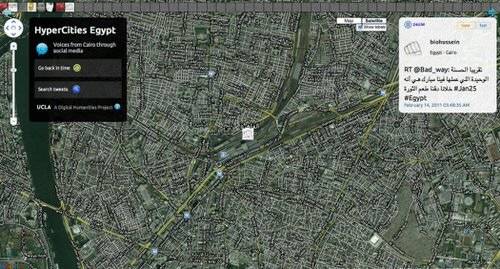Let the pundits continue to debate whether or not social media and Twitter enabled the revolutions in Egypt and Tunisia. Digital humanities scholars are already on the case, pulling together the digital archives and the visualizations of the social media records from the events.

One such project: Hypercities, a research project “for traveling back in time to explore the historical layers of city spaces in an interactive, hypermedia environment.” Hypercities has recently turned its attention to Egypt, and its team of digital humanities scholars – Yoh Kawano, Todd Presner, and David Shepard – have created a live, interactive map of all the tweets in Cairo, viewable at http://egypt.hypercities.com/.
The project usesTwitter’s search API, requesting all tweets within a few miles of the center of Cairo or which contain hashtags like #Egypt or #Jan25. These tweets are shown live on a map, and are also downloaded and stored in a database. The purpose, in part, is to be able to archive this important historical moment, so that scholars can go back through the records of the tweets – some 300,000 associated with the #jan25 and #egypt hashtags.
As PhD candidate David Shepard argues, “Our purpose was twofold: to create an experience of the protests more immediate to the rest of the world than what we see on TV, and to create an archive to preserve the tweets for future work. The power of social media in the Egyptian protests has already been well-commented upon and debated. Our project doesn’t attempt to engage with the debate over the effectiveness of social media in accomplishing the revolution. HyperCities Egypt was more about creating a focal point for making Egyptian Tweeters’ messages accessible to the rest of the world.”


















